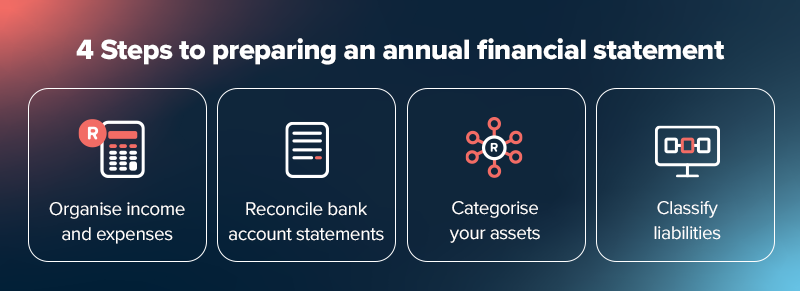If you’re like most busy small business owners, your annual financial statement (AFS) only becomes a priority when your accountant calls – or a lender asks for it.
Yet this vital summary of your business’s financial health isn’t just for compliance purposes; it can also unlock the door to funding that helps you grow.
The problem is, you may not be sure how to create such a document or what to include in it, not to mention how to keep it compliant with the latest standards.
This guide will walk you through the key steps you must follow to do this successfully, including:
- Which assets, liabilities, income and expenses should you use;
- How to stay in line with the latest accounting standards; and
- How to use your annual financial statement to get greater clarity on your financial position.
Let’s start by breaking down what an annual financial statement actually is – and why it matters more than you might think. Download our annual financial statement checklist for small businesses.
What is an Annual Financial Statement?
An annual financial statement for small businesses goes beyond being just a compliance checkbox and tells a business’s story over a full financial year.
As a small business owner, you’ll get a clear, structured view of your financial performance and position at year-end if you do it correctly. This will help you make better decisions and present a trustworthy picture to potential funders or partners.
Your company’s annual financial statement typically includes three core reports:
1. Income statement (statement of comprehensive income)
This report shows how much revenue your business earned and what it cost to earn it, including operating expenses, taxes and interest. The result is your net profit or loss for the year.
Knowing this helps you track financial performance and profitability over a certain period of time, both key metrics for funders and internal planning.
2. Balance sheet (statement of financial position)
A snapshot of your business at year-end, the balance sheet breaks down your company’s assets (what you own), liabilities (what you owe), and net assets or equity (what’s left).
This helps you understand your solvency, capital structure, and whether you can meet short- and long-term obligations.
3. Statement of cash flows
Commonly known as a cash flow statement, this details cash movement across operating, investing and financing activities.
Together, these statements reflect your business’s fiscal health and help you to manage risk, plan growth and unlock funding opportunities.
Investors and lenders will often ask to see these documents before they decide whether to invest, so preparing them is an important step for ambitious businesses that need growth funding.
Who Prepares Annual Financial Statements?
The person responsible for preparing annual financial statements depends on the type and size of the company.
For small South African businesses, an external accountant is the most effective person for this task.
Larger businesses, meanwhile, will have an internal financial team to handle the more elaborate finances. The management or the board of directors is ultimately accountable, so many delegate the process to trusted professionals who cover all eventualities.
Regardless of who does it, statements must follow the appropriate financial reporting standards – either IFRS (International Financial Reporting Standards) or simplified frameworks for smaller entities.
How to Prepare Annual Financial Statements
Preparing annual financial statements of a company starts with disciplined record-keeping throughout the year. Before your year-end, you’ll need to:
- Organise income and expenses
- Reconcile bank account statements
- Categorise your assets (non-current assets like equipment and intangible assets; short-term assets like accounts receivable and cash equivalents)
- Classify liabilities (short-term payables and long-term debts like loans or tax liabilities)

Once you have these, you or your accountant will need to make sure this information is in line with consistent accounting policies and standards, including the IFRS, as mentioned above.
Knowing how to calculate working capital and checking your liquidity position is also extremely useful, especially if you’re preparing for funding – these workings can accompany your company’s financial statements.
Most SMEs benefit from using accounting software to streamline the process and generate reliable financial information.
The goal? Accurate, easy-to-read statements that stand up to external scrutiny and support your growth plans.
How to Analyse Annual Financial Statements
Preparing your annual financial statement is one thing – analysing it is what turns the data into decisions. For South African SMEs looking to expand or secure funding, this is where you show financial strength and repayment capacity.
Start with your income statement and ask yourself the following questions: Are profits growing year-on-year? Then look at your balance sheet: Is your business liquid enough to cover short-term obligations? Are you overleveraged?
Key ratios – like debt-to-equity, liquidity, or working capital turnover – help you gauge efficiency and financial stability.
Don’t overlook the cash flow statement. It shows whether you’re actually generating cash from core operations, not just paper profits.
Many lenders use this analysis to perform a valuation, assess risk and decide whether to support your next move. If you can understand the numbers yourself, you’ll be in a stronger position to explain your business’s financial story and secure the resources to grow.
How to Submit Your Annual Financial Statement
In South Africa, your AFS is a required part of your company’s annual return, which you must submit to the Companies and Intellectual Property Commission (CIPC).
Since 2018, the CIPC has only accepted these annual reports in iXBRL format through their eServices portal, which adds a layer of admin that can trip up even the most organised business owners.
You usually won’t need to submit your full AFS directly to SARS when filing your company tax return, but SARS can request it during an audit or verification – and when they do, you’ll need it ready.
If you’re applying for funding from a traditional lender in South Africa, your AFS becomes even more important.
Banks and other institutions typically ask for your consolidated financial statements – including your income statement, balance sheet and cash flow statement – often signed off by a registered auditor. They use these to understand your fiscal health and risk profile before making a lending decision.
Skip the AFS: Get Business Funding Faster with Lula
Let’s face it: applying for business funding through traditional banks can feel like jumping through hoops.
Endless paperwork. Outdated documents. A full annual financial statement signed off by an auditor – and that’s just to get started.
At Lula, we do things differently.
We know small businesses move fast – and your funding should too. That’s why we’ve cut the red tape. Instead, you simply link your bank account or upload your statements securely and our tech team reviews your transaction data to assess your business’s performance. No chasing accountants, no delays.
Just a fast, flexible decision based on how your business is doing right now. So you can skip the stress and get back to what matters: growing your business.
Ready to move faster? We’ve got your back.






